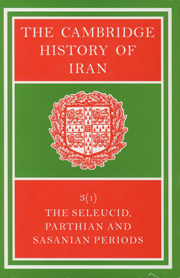Book contents
- Frontmatter
- Introduction
- PART 1 POLITICAL HISTORY
- 1 THE SELEUCID PERIOD
- 2 THE POLITICAL HISTORY OF IRAN UNDER THE ARSACIDS
- 3 IRANIANS IN ASIA MINOR
- 4 THE POLITICAL HISTORY OF IRAN UNDER THE SASANIANS
- 5 THE HISTORY OF EASTERN IRAN
- 6 THE POLITICAL HISTORY OF TRANSOXIANA
- 7 THE IRANIAN SETTLEMENTS TO THE EAST OF THE PAMIRS
- PART 2 NUMISMATICS
- PART 3 IRANIAN HISTORICAL TRADITION
- PART 4 IRAN AND HER NEIGHBOURS
- Bibliography
- Plate section
- Plate section
- Plate section
- Map 3. The western regions of the Sasanian empire">
- Map 11. The Silk Road from China to the Roman Orient
- References
3 - IRANIANS IN ASIA MINOR
from PART 1 - POLITICAL HISTORY
Published online by Cambridge University Press: 28 March 2008
- Frontmatter
- Introduction
- PART 1 POLITICAL HISTORY
- 1 THE SELEUCID PERIOD
- 2 THE POLITICAL HISTORY OF IRAN UNDER THE ARSACIDS
- 3 IRANIANS IN ASIA MINOR
- 4 THE POLITICAL HISTORY OF IRAN UNDER THE SASANIANS
- 5 THE HISTORY OF EASTERN IRAN
- 6 THE POLITICAL HISTORY OF TRANSOXIANA
- 7 THE IRANIAN SETTLEMENTS TO THE EAST OF THE PAMIRS
- PART 2 NUMISMATICS
- PART 3 IRANIAN HISTORICAL TRADITION
- PART 4 IRAN AND HER NEIGHBOURS
- Bibliography
- Plate section
- Plate section
- Plate section
- Map 3. The western regions of the Sasanian empire">
- Map 11. The Silk Road from China to the Roman Orient
- References
Summary
A fragment by an Athenian tragedian of the late 5th or early 4th centuries speaks of maidens from Lydia and Bactria together, worshipping the Tmolian goddess Artemis to the sound of a flute, welcoming the deity like a guest with a Persian melody. The Tmolian goddess is most likely Anaitis, often referred to as the Persian Artemis, since Hypaipa, one of the centres of worship of Anaitis in Lydia, lay on the slopes of Mount Tmolus. Bactria, at the other end of the dominions of the Achaemenians on the Oxus, was also an important centre of the worship of Anaitis. Poets in Athens and presumably individuals in Lydia imagined Lydian maidens worshipping the same goddess as maidens at the end of the inhabited world. Thinking this way meant fitting local customs and even local thoughts into a wider whole which may have been perceived as in some sense living – organization was not merely a matter of roads and fast postal service. The deities of the Persians ranged throughout the dominions of the Achaemenians. Darius in the Bisitun inscription refers often to his rule's relation to Ahuramazda. This sense of belonging to a whole, which stretched to the ends of the inhabited world, also finds expression in the custom of Persians of sacrificing for the king and for all Persians but not for themselves (Herodotus 1. 131).
- Type
- Chapter
- Information
- The Cambridge History of Iran , pp. 100 - 115Publisher: Cambridge University PressPrint publication year: 1983
References
- 3
- Cited by



